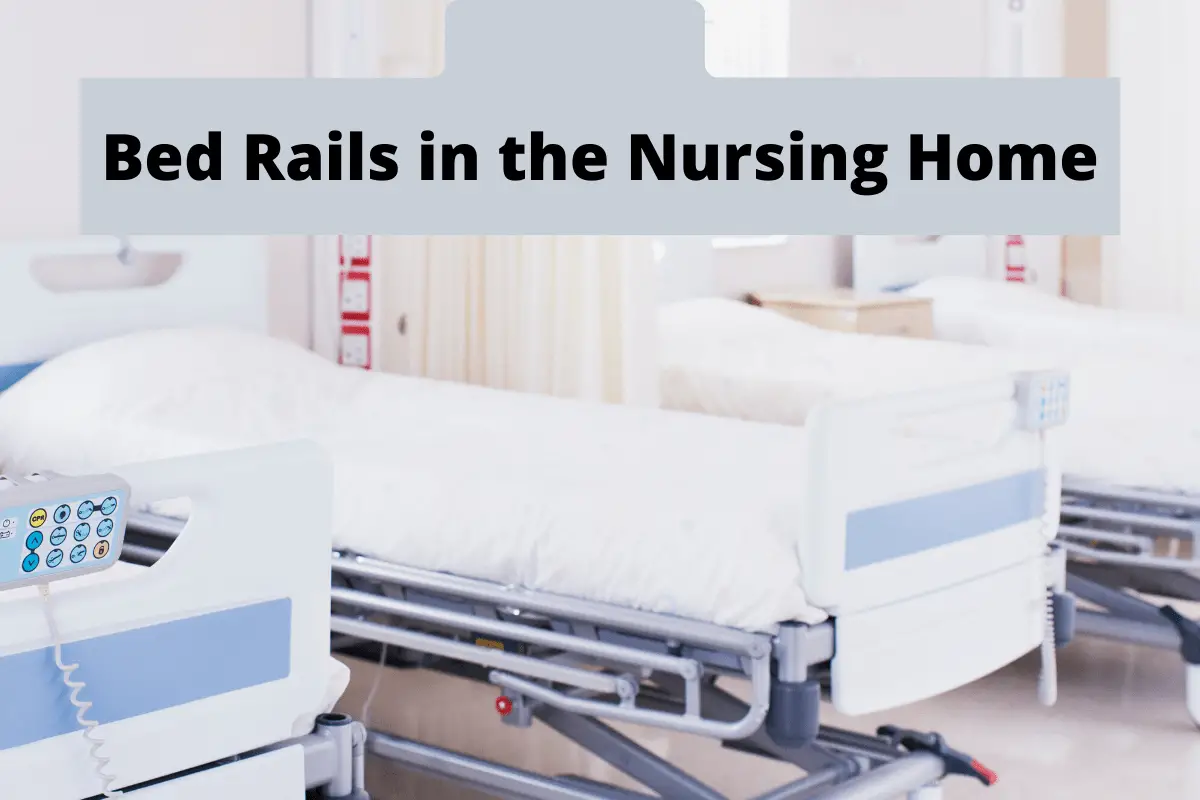In the past, nursing homes utilized restraints to provide a “safe way of keeping a patient out of danger.” However, as time progressed, it has been shown that most restraints cause more potential harm to the patient than being helpful.
Between 1985 and January 1, 2009, 803 incidents of patients* caught, trapped, entangled, or strangled in beds with rails were reported to the U.S. Food and Drug Administration.[i]
There are many reasons why full-length rails were used in the past, including:
- The perceived safety of a resident
- A way to contain the patient
- Preventing patient from wandering
However, patients can get “entrapped” when they attempt to move or shift off the bed. The residents may have dementia and not realize the rails are blocking their way. They may also need to use the bathroom and feel they can navigate around the rail.
Some states still allow full side rails if the patient or power of attorney agrees and signs consent allowing their use. Without approval, they are considered a restraint and cannot be used.
“CMS recognizes that there are many different types of beds, some with bed rails installed, or bed rails with the call button and lights incorporated into the rail, and others without bed rails, for which a separate rail could be installed.”
The facility must try to use alternative methods before installing rails. The facility also needs to make sure these rails are installed properly.
Before using the rails, make sure the facility assessing the resident for risk of entrapment before installing bed rails.
Are full bed rails safe for the elderly?
Full handrails have been shown to be unsafe for elderly residents—especially patients with advanced dementia or disabilities, preventing them from using their extremities.
There are zones of entrapment with full handrails. One is when the patient rolls between the bed and the rails. Another is when the resident’s head gets caught between the upper portion of the rail. Sometimes the patient’s head may fit between the handrails.
Patients have been known to slide off the bed under the rails either head first or feet first and then meeting resistance, and they slide down.
These same residents that can become entrapped between the rails and the bed usually lack the strength to get themselves out. They may also require coordination to maneuver themselves out of the position that may harm them.
It doesn’t appear there are laws regarding the manufacturing of the beds yet. However, the facility is responsible for correctly installing these beds. They are needed to maintain the bed and rails. They need to assess the risks of the patient when it comes to the rails. They will need to make sure the bed’s dimensions are appropriate for the size and weight of the patient.
Most facilities realize the risks of the full rails and the restrictions of their use. Therefore, they utilize the half rails. Some people complain when their loved one falls out of bed, stating that if they had a full rail, their mother wouldn’t have fallen. However, most people, if they want to get out of bed, will find a way to get out of the bed over the rail or get stuck in the process.
Are bed rails considered restraints?
After explaining all the harmful effects of full-side rails, you can see how they are considered restraints. Therefore, most states have specific rules regarding the limitation of their use.
Partial bedrails are not considered restraints because they can assist the patient in getting up and out of the bed, whereas full rails prevent this from happening.
Even though the rails are considered restraints, there are some states that allow their use with signed agreements by the POA or patient. They need to agree to their use, along with a proper explanation of the risks regarding their use.
Why would patients want side rails?
There are a few reasons why patients and their families would want to have side rails on their beds. It doesn’t matter if it’s a half or a full rail many people think there is a benefit to having the rails.
The rails give the patients a false sense of security and safety. The patient feels that if they roll over why sleeping, the rail will prevent them from falling off the bed.
There is also the position of the rails that assist the patient in repositioning and movement in the bed. It helps the patient shift their bodies and pull themselves into a sitting position.
Why should patients and their families not want side rails?
The main reason for not wanting a full side rail is apparent …they are not considered safe. You may like the ability to position yourself using the rails and help you stay in bed.
However, for many patients with dementia or physical disabilities, the risks of using the side rails outweigh the benefits. Do you want to see your loved one get trapped between the bed and the rails? Imagine them climbing over the rail and falling to the ground below.
Some people say that their loved one is alert and oriented, and this could never happen to them. What happens if your loved one had a stroke during the night or develops a urinary tract infection, which results in lots of confusion?
How can I protect the patient if we don’t use side rails?
There are things the family and healthcare staff can do to protect the patient. First, always keep the bed in the lowest position whenever the bed is locked.
Some patients may require the use of pads around the bed to help avoid injury if they fall out of the rail-less bed.
More importantly, monitor the patient for reasons they may want to get out of bed in the first place. Do they need to use the toilet? Are they in pain?
Conclusion
Back in the day, the rule was to “Keep the side rails up whenever the patient wasn’t attended.” Now with more data regarding the safety or lack thereof regarding the use of full railings on beds, facilities no longer rely on them to protect the patient.
“On September 28, 2016, the Centers for Medicare & Medicaid Services (CMS) issued updated federal nursing home regulations.” The final phase went into effect in 2019.
References:
Clarification from CMS about Requirements of Participation related to the use of bed rails. https://txhca.org/article/clarification-from-cms-about-requirements-of-participation-related-to-use-of-bed-rails Retrieved February 19, 2020
National Consumer Voice for Quality Long-Term Care. https://theconsumervoice.org/uploads/files/issues/summary-of-key-changes-effective-phase-1-part-2-FINAL.pdf Retrieved February 19, 2020
U.S. Food and Drug Administration. A Guide to Bed Safety Bed Rails in Hospitals, Nursing Homes and Home Health Care: The Fact https://www.fda.gov/medical-devices/hospital-beds/guide-bed-safety-bed-rails-hospitals-nursing-homes-and-home-health-care-facts Retrieved February 18, 2020


